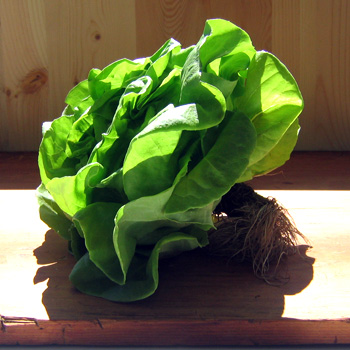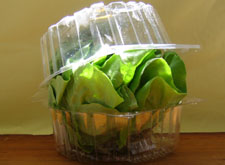 Hydroponically-grown Boston Lettuce
Hydroponically-grown Boston Lettuce© Denzil Green
Boston Lettuce is a member of the Butterhead family of Lettuces. It is a bit larger than a Bibb Lettuce, which is also in the Butterhead family.
The leaves of Boston Lettuce, which are soft and tender, are so easily bruised that the lettuce is often shipped in protective plastic containers called “clamshells.” The leaves form a loose, round head with yellow-green leaves at the centre.
All the leaves have a taste that is so lacking in bitterness that you could almost call them sweet.
Cooking Tips
Core the bottom, then remove leaves and wash in a large bowl or in a sink of cold water. Wash well, as the leaves can catch a lot of sand (though many are grown hydroponically these days and shipped with the roots still on.) There is no need to let the leaves soak in water, though. Dry afterwards. The leaves bruise easily, so handle carefully.
The leaves pair well with fruitier dressings, and with sweeter items such as cherry tomatoes or grated carrot.
Equivalents
1 pound lettuce = 450g = approx 6 cups torn
8 oz lettuce = 225g = approx 3 cups torn
2 oz shredded lettuce = 50g = 1 cup
8 oz shredded lettuce = 200g = 4 cups
Storage Hints
Boston Lettuce in its clamshell
© Denzil Green
Store washed leaves in a sealed plastic bag for up to 5 days.
Unlike other lettuces where the danger is storing them wet and allowing mould to develop, with Boston Lettuce the storage worry is about the leaves drying out.
The plastic clamshell containers serve double duty, not only protecting them from bruising, but also keeping moisture in. If your Boston Lettuce came in a clamshell, store washed leaves in the clamshell.
History Notes
Boston Lettuce been grown in Florida since at least the 1920s as a winter crop for shipping north.


